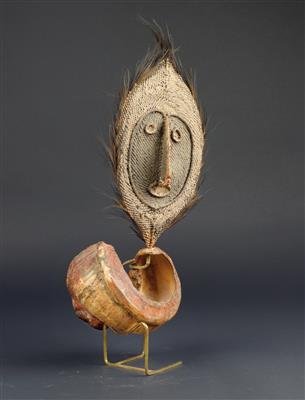New Guinea: A ‘talipun’ dowry. Tribe: Boiken, east Sepik Province.

These famous and complex objects have been and continue to be used as a form of ‘primitive money’ in northern New Guinea. They are used for dowry payments between families, as well as for transactions between individuals or entire villages.
A ‘talipun’ consists of a large piece of the sea snail ‘turbo marmoratus’ attached to a woven ancestral face.
The large turban snails are found on the north coast of New Guinea and traded inland to the Yangoru Boiken in the Prince Alexander Mountains. The Boiken weave the ancestral faces, colour and paint them with clay, decorate them with cassowary feathers and mount the ‘ancestors’ on top of the snail shells. The finished ‘talipun’ is then used as a form of currency (dowries) or traded to the surrounding Papua tribes (Iatmul, Lumi, Abelam et al.). Even today, ‘talipuns’, in combination with modern currency, are considered valuable trade items.
The present ‘talipun’ is a very beautiful, old and complete example of this early form of ‘money’: The lancet-shaped, flat head crest is made of tightly woven rattan, dyed with ochre and decorated along the outer rim with black cassowary feathers. The typical, heart-shaped face, with eyes, mouth and nose, is accentuated by the grey clay colouring. The long nose protrudes in front, and its septum is pierced. The large fragment of ‘turbo marmoratus’ snail is visibly very old and displays remnants of an earlier, red colouring.
An item with noticeable, old signs of use (bridge of the nose and snail). Best condition, hardly any damage.
First third of the 20th century; H: 52 cm (total). 38 cm (ancestral face weave). (ME)
Provenance: Galerie Bienenstein, Vienna; Austrian Private Collection.
Lit.: ‘Art Papou’, Musées de Marseille (catalogue), ill. 307, 308; ‘Museo delle Culture Extraeuropee. Serge and Graziella Brignoni’ collection, Lugano, ill. p. 52.
Esperto: Prof. Erwin Melchardt
 Prof. Erwin Melchardt
Prof. Erwin Melchardt
+43-1-515 60-465
erwin.melchardt@dorotheum.at
26.05.2015 - 15:00
- Stima:
-
EUR 1.600,- a EUR 2.000,-
New Guinea: A ‘talipun’ dowry. Tribe: Boiken, east Sepik Province.
These famous and complex objects have been and continue to be used as a form of ‘primitive money’ in northern New Guinea. They are used for dowry payments between families, as well as for transactions between individuals or entire villages.
A ‘talipun’ consists of a large piece of the sea snail ‘turbo marmoratus’ attached to a woven ancestral face.
The large turban snails are found on the north coast of New Guinea and traded inland to the Yangoru Boiken in the Prince Alexander Mountains. The Boiken weave the ancestral faces, colour and paint them with clay, decorate them with cassowary feathers and mount the ‘ancestors’ on top of the snail shells. The finished ‘talipun’ is then used as a form of currency (dowries) or traded to the surrounding Papua tribes (Iatmul, Lumi, Abelam et al.). Even today, ‘talipuns’, in combination with modern currency, are considered valuable trade items.
The present ‘talipun’ is a very beautiful, old and complete example of this early form of ‘money’: The lancet-shaped, flat head crest is made of tightly woven rattan, dyed with ochre and decorated along the outer rim with black cassowary feathers. The typical, heart-shaped face, with eyes, mouth and nose, is accentuated by the grey clay colouring. The long nose protrudes in front, and its septum is pierced. The large fragment of ‘turbo marmoratus’ snail is visibly very old and displays remnants of an earlier, red colouring.
An item with noticeable, old signs of use (bridge of the nose and snail). Best condition, hardly any damage.
First third of the 20th century; H: 52 cm (total). 38 cm (ancestral face weave). (ME)
Provenance: Galerie Bienenstein, Vienna; Austrian Private Collection.
Lit.: ‘Art Papou’, Musées de Marseille (catalogue), ill. 307, 308; ‘Museo delle Culture Extraeuropee. Serge and Graziella Brignoni’ collection, Lugano, ill. p. 52.
Esperto: Prof. Erwin Melchardt
 Prof. Erwin Melchardt
Prof. Erwin Melchardt
+43-1-515 60-465
erwin.melchardt@dorotheum.at
|
Hotline dell'acquirente
lun-ven: 10.00 - 17.00
kundendienst@dorotheum.at +43 1 515 60 200 |
| Asta: | Arte Tribale |
| Tipo d'asta: | Asta in sala |
| Data: | 26.05.2015 - 15:00 |
| Luogo dell'asta: | Wien | Palais Dorotheum |
| Esposizione: | 20.05. - 26.05.2015 |
